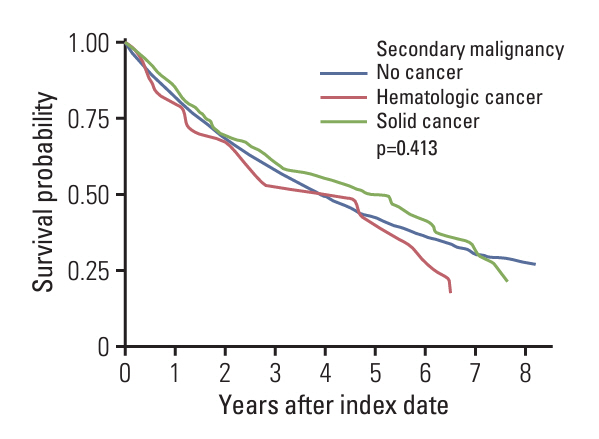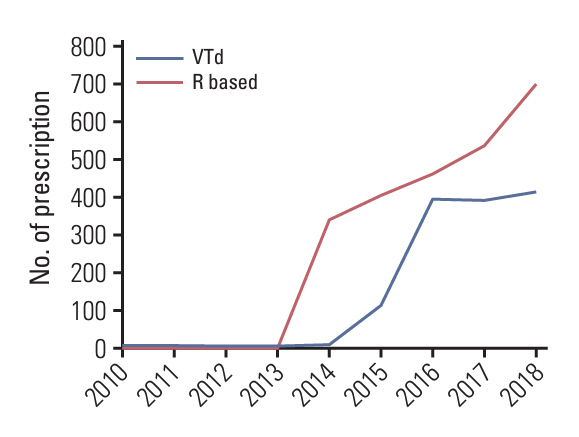Cancer Res Treat.
2024 Jul;56(3):936-944. 10.4143/crt.2023.843.
Secondary Malignancies in Multiple Myeloma in Korean Patients: A Nationwide Population-Based Study
- Affiliations
-
- 1Department of Preventive Medicine, Hanyang University College of Medicine, Seoul, Korea
- 2Hanyang Institute of Bioscience and Biotechnology, Hanyang University, Seoul, Korea
- 3Department of Hematology-Oncology, Center for Hematologic Malignancy, National Cancer Center, Goyang, Korea
- 4Medical Affairs, Janssen Korea, Seoul, Korea
- KMID: 2557680
- DOI: http://doi.org/10.4143/crt.2023.843
Abstract
- Purpose
This study investigated the incidence of secondary malignancy in multiple myeloma (MM) patients compared with that in the general population using a population-based database covering all residents in Korea.
Materials and Methods
Based on the national health insurance system in Korea, all people primarily diagnosed with MM between January 1, 2010 to December 31, 2018 were identified. A total of 9,985 MM patients aged ≥ 20 years in Korea were included.
Results
Among them, 237 (2.4%) developed secondary malignancies by 2018. The standardized incidence rates (SIRs) of all secondary malignancies in MM patients were 0.87 (95% confidence interval [CI], 0.76 to 0.98), with a higher incidence of hematologic malignancies than in the general population with an SIR of 3.80 (95% CI, 2.61 to 5.00). The incidence rates of both lymphoid malignancy (SIR, 3.56; 95% CI, 2.31 to 4.82) and myeloid malignancy (SIR, 3.78; 95% CI, 1.16 to 6.39) were higher in MM patients than in the general population. In contrast, a lower incidence of solid cancer was observed in MM patients than in the general population (SIR, 0.76, 95% CI, 0.65 to 0.86). There was no significant difference in survival in MM patients without secondary malignancies, with hematologic malignancy, and with solid cancer (p=0.413).
Conclusion
MM patients had a greater risk of secondary malignancies, especially hematologic malignancies, than the general population. Future studies with a focus on analyzing patients’ history, treatment details, and genetic information in various stages of MM patients are needed to better understand the mechanism behind this increased risk.
Figure
Reference
-
References
1. Sung H, Ferlay J, Siegel RL, Laversanne M, Soerjomataram I, Jemal A, et al. Global cancer statistics 2020: GLOBOCAN estimates of incidence and mortality worldwide for 36 cancers in 185 countries. CA Cancer J Clin. 2021; 71:209–49.2. Turesson I, Velez R, Kristinsson SY, Landgren O. Patterns of improved survival in patients with multiple myeloma in the twenty-first century: a population-based study. J Clin Oncol. 2010; 28:830–4.
Article3. Thomas A, Mailankody S, Korde N, Kristinsson SY, Turesson I, Landgren O. Second malignancies after multiple myeloma: from 1960s to 2010s. Blood. 2012; 119:2731–7.
Article4. Thorsteinsdottir S, Dickman PW, Landgren O, Blimark C, Hultcrantz M, Turesson I, et al. Dramatically improved survival in multiple myeloma patients in the recent decade: results from a Swedish population-based study. Haematologica. 2018; 103:e412–5.
Article5. Maclachlan K, Diamond B, Maura F, Hillengass J, Turesson I, Landgren CO, et al. Second malignancies in multiple myeloma: emerging patterns and future directions. Best Pract Res Clin Haematol. 2020; 33:101144.
Article6. Musto P, Anderson KC, Attal M, Richardson PG, Badros A, Hou J, et al. Second primary malignancies in multiple myeloma: an overview and IMWG consensus. Ann Oncol. 2017; 28:228–45.
Article7. Poh C, Keegan T, Rosenberg AS. Second primary malignancies in multiple myeloma: a review. Blood Rev. 2021; 46:100757.
Article8. Huang J, Chan SC, Lok V, Zhang L, Lucero-Prisno DE 3rd, Xu W, et al. The epidemiological landscape of multiple myeloma: a global cancer registry estimate of disease burden, risk factors, and temporal trends. Lancet Haematol. 2022; 9:e670–7.
Article9. Tzeng HE, Lin CL, Tsai CH, Tang CH, Hwang WL, Cheng YW, et al. Time trend of multiple myeloma and associated secondary primary malignancies in Asian patients: a Taiwan population-based study. PLoS One. 2013; 8:e68041.
Article10. Liu Y, Hou HA, Qiu H, Tang CH. Is the risk of second primary malignancy increased in multiple myeloma in the novel therapy era? A population-based, retrospective cohort study in Taiwan. Sci Rep. 2020; 10:14393.
Article11. Lee J, Lee JS, Park SH, Shin SA, Kim K. Cohort profile: The National Health Insurance Service-National Sample Cohort (NHIS-NSC), South Korea. Int J Epidemiol. 2017; 46:e15.
Article12. Yang MS, Park M, Back JH, Lee GH, Shin JH, Kim K, et al. Validation of cancer diagnosis based on the National Health Insurance Service Database versus the National Cancer Registry Database in Korea. Cancer Res Treat. 2022; 54:352–61.
Article13. Tang CH, Liu HY, Hou HA, Qiu H, Huang KC, Siggins S, et al. Epidemiology of multiple myeloma in Taiwan, a population based study. Cancer Epidemiol. 2018; 55:136–41.
Article14. Quan H, Sundararajan V, Halfon P, Fong A, Burnand B, Luthi JC, et al. Coding algorithms for defining comorbidities in ICD-9-CM and ICD-10 administrative data. Med Care. 2005; 43:1130–9.
Article15. Kim KH. Comparative study on three algorithms of the ICD-10 Charlson comorbidity index with myocardial infarction patients. J Prev Med Public Health. 2010; 43:42–9.
Article16. Charlson ME, Pompei P, Ales KL, MacKenzie CR. A new method of classifying prognostic comorbidity in longitudinal studies: development and validation. J Chronic Dis. 1987; 40:373–83.17. Rosenberg AS, Brunson A, Tuscano J, Jonas BA, Hoeg R, Wun T, et al. Effect of autologous hematopoietic stem cell transplant on the development of second primary malignancies in multiple myeloma patients. Blood Cancer J. 2021; 11:5.
Article18. Miller JS, Arthur DC, Litz CE, Neglia JP, Miller WJ, Weisdorf DJ. Myelodysplastic syndrome after autologous bone marrow transplantation: an additional late complication of curative cancer therapy. Blood. 1994; 83:3780–6.19. Palumbo A, Bringhen S, Kumar SK, Lupparelli G, Usmani S, Waage A, et al. Second primary malignancies with lenalidomide therapy for newly diagnosed myeloma: a meta-analysis of individual patient data. Lancet Oncol. 2014; 15:333–42.
Article20. Lee H, Park HJ, Park EH, Ju HY, Oh CM, Kong HJ, et al. Nationwide statistical analysis of lymphoid malignancies in Korea. Cancer Res Treat. 2018; 50:222–38.
Article21. Saleem K, Franz J, Klem ML, Yabes JG, Boyiadzis M, Jones JR, et al. Second primary malignancies in patients with haematological cancers treated with lenalidomide: a systematic review and meta-analysis. Lancet Haematol. 2022; 9:e906–18.22. Dimopoulos M, Spencer A, Attal M, Prince HM, Harousseau JL, Dmoszynska A, et al. Lenalidomide plus dexamethasone for relapsed or refractory multiple myeloma. N Engl J Med. 2007; 357:2123–32.
Article23. Wang J, Lv C, Zhou M, Xu JY, Chen B, Wan Y. Second primary malignancy risk in multiple myeloma from 1975 to 2018. Cancers (Basel). 2022; 14:4919.
Article24. Jones JR, Cairns DA, Gregory WM, Collett C, Pawlyn C, Sigsworth R, et al. Second malignancies in the context of lenalidomide treatment: an analysis of 2732 myeloma patients enrolled to the Myeloma XI trial. Blood Cancer J. 2016; 6:e506.
Article25. Cooper JD, Thornton JA, Gibson SJ, Pham K, Sunderland K, DeStefano CB. Survival of patients with multiple myeloma diagnosed with second primary malignancies: an ASCO Cancerlinq analysis. Blood. 2022; 140(Suppl 1):10039–40.
Article26. Lonial S, Jacobus S, Fonseca R, Weiss M, Kumar S, Orlowski RZ, et al. Randomized trial of lenalidomide versus observation in smoldering multiple myeloma. J Clin Oncol. 2020; 38:1126–37.
Article27. Cavo M, Gay F, Beksac M, Pantani L, Petrucci MT, Dimopoulos MA, et al. Autologous haematopoietic stem-cell transplantation versus bortezomib-melphalan-prednisone, with or without bortezomib-lenalidomide-dexamethasone consolidation therapy, and lenalidomide maintenance for newly diagnosed multiple myeloma (EMN02/HO95): a multicentre, randomised, open-label, phase 3 study. Lancet Haematol. 2020; 7:e456–68.
Article28. Attal M, Lauwers-Cances V, Marit G, Caillot D, Moreau P, Facon T, et al. Lenalidomide maintenance after stem-cell transplantation for multiple myeloma. N Engl J Med. 2012; 366:1782–91.
Article29. Facon T, Dimopoulos MA, Dispenzieri A, Catalano JV, Belch A, Cavo M, et al. Final analysis of survival outcomes in the phase 3 FIRST trial of up-front treatment for multiple myeloma. Blood. 2018; 131:301–10.
Article
- Full Text Links
- Actions
-
Cited
- CITED
-
- Close
- Share
- Similar articles
-
- A Case of Generalized Plane Xanthoma Associated with Multiple Myeloma and Hyperlipoproteinemia
- Multiple myeloma
- A Case of Maxillary Sinus Involvement in Multiple Myeloma
- Nonsecretory Multiple Myeloma associated with Immune Thrombocytopenia and Complicated by Malignant Ascites
- Continuous Multiple Vertebral Compression Fractures in Multiple Myeloma Patient



